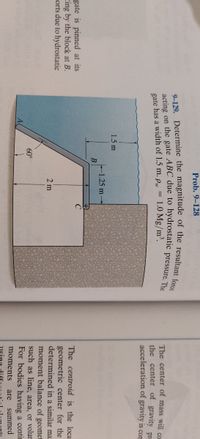
Elements Of Electromagnetics
7th Edition
ISBN: 9780190698614
Author: Sadiku, Matthew N. O.
Publisher: Oxford University Press
expand_more
expand_more
format_list_bulleted
Topic Video
Question

Transcribed Image Text:**Problem 9-128**
**Objective:** Determine the magnitude of the resultant force acting on the gate ABC due to hydrostatic pressure. The gate has a width of 1.5 m, and the density of water (\(\rho_w\)) is 1.0 Mg/m³.
**Diagram Description:**
The diagram presents a cross-sectional view of a gate submerged in water, hinged at point A and supported by a block at point B. The geometry is triangular with the following details:
- The gate is inclined at an angle of \(60^\circ\) to the horizontal.
- The height from the water surface to point B is marked as 1.5 m.
- The segment BC is vertical with a length of 2 m.
- The part from the block at B to C is horizontal and measures 1.25 m.
- The width of the gate is given as 1.5 m.
**Technical Explanation:**
To determine the resultant force on the gate due to the hydrostatic pressure, consider the following steps:
1. **Calculate the Hydrostatic Force:**
The pressure exerted by the fluid at any depth is given by \( P = \rho \cdot g \cdot h \), where:
- \(\rho\) is the fluid density,
- \(g\) is the acceleration due to gravity,
- \(h\) is the depth below the fluid surface.
2. **Determine the Position of the Center of Pressure:**
The center of pressure is the centroid for hydrostatic loading, factoring in both depth and gate geometry.
3. **Compute the Moments:**
Using moment calculations, find the tendency of this force to cause rotation about the hinge point A.
For educational purposes, these calculations demonstrate how principles of fluid statics and engineering mechanics are applied to real-world scenarios involving submerged gates and fluid forces.
Expert Solution
This question has been solved!
Explore an expertly crafted, step-by-step solution for a thorough understanding of key concepts.
This is a popular solution
Trending nowThis is a popular solution!
Step by stepSolved in 4 steps with 1 images

Knowledge Booster
Learn more about
Need a deep-dive on the concept behind this application? Look no further. Learn more about this topic, mechanical-engineering and related others by exploring similar questions and additional content below.Similar questions
- 20: Determine the magnitude of the pin reaction at A and the magnitude and direction of the force reaction at the rollers. Neglect the size of the pulleys. Complete fbd.arrow_forwardA tank is filled with oil whose density is ρ = 850 kg/m3. If the volume of the tank is V = 2 m3, determine the amount of mass m in the tank.arrow_forwardThe concrete gravity dam is held in place by its own weight. If the density of concrete is 2.5 Mg/m3, and water has a density of 1.0 Mg/m³, determine the magnitude of the total resultant force the water exerts on the dam. The width of the dam is 10 m, and d=3 m. F m- 6 m -d – 1–| 1861 kN 1789 kN 1776 kN 1941 kN 1960 kNarrow_forward
arrow_back_ios
arrow_forward_ios
Recommended textbooks for you
 Elements Of ElectromagneticsMechanical EngineeringISBN:9780190698614Author:Sadiku, Matthew N. O.Publisher:Oxford University Press
Elements Of ElectromagneticsMechanical EngineeringISBN:9780190698614Author:Sadiku, Matthew N. O.Publisher:Oxford University Press Mechanics of Materials (10th Edition)Mechanical EngineeringISBN:9780134319650Author:Russell C. HibbelerPublisher:PEARSON
Mechanics of Materials (10th Edition)Mechanical EngineeringISBN:9780134319650Author:Russell C. HibbelerPublisher:PEARSON Thermodynamics: An Engineering ApproachMechanical EngineeringISBN:9781259822674Author:Yunus A. Cengel Dr., Michael A. BolesPublisher:McGraw-Hill Education
Thermodynamics: An Engineering ApproachMechanical EngineeringISBN:9781259822674Author:Yunus A. Cengel Dr., Michael A. BolesPublisher:McGraw-Hill Education Control Systems EngineeringMechanical EngineeringISBN:9781118170519Author:Norman S. NisePublisher:WILEY
Control Systems EngineeringMechanical EngineeringISBN:9781118170519Author:Norman S. NisePublisher:WILEY Mechanics of Materials (MindTap Course List)Mechanical EngineeringISBN:9781337093347Author:Barry J. Goodno, James M. GerePublisher:Cengage Learning
Mechanics of Materials (MindTap Course List)Mechanical EngineeringISBN:9781337093347Author:Barry J. Goodno, James M. GerePublisher:Cengage Learning Engineering Mechanics: StaticsMechanical EngineeringISBN:9781118807330Author:James L. Meriam, L. G. Kraige, J. N. BoltonPublisher:WILEY
Engineering Mechanics: StaticsMechanical EngineeringISBN:9781118807330Author:James L. Meriam, L. G. Kraige, J. N. BoltonPublisher:WILEY

Elements Of Electromagnetics
Mechanical Engineering
ISBN:9780190698614
Author:Sadiku, Matthew N. O.
Publisher:Oxford University Press

Mechanics of Materials (10th Edition)
Mechanical Engineering
ISBN:9780134319650
Author:Russell C. Hibbeler
Publisher:PEARSON

Thermodynamics: An Engineering Approach
Mechanical Engineering
ISBN:9781259822674
Author:Yunus A. Cengel Dr., Michael A. Boles
Publisher:McGraw-Hill Education

Control Systems Engineering
Mechanical Engineering
ISBN:9781118170519
Author:Norman S. Nise
Publisher:WILEY

Mechanics of Materials (MindTap Course List)
Mechanical Engineering
ISBN:9781337093347
Author:Barry J. Goodno, James M. Gere
Publisher:Cengage Learning

Engineering Mechanics: Statics
Mechanical Engineering
ISBN:9781118807330
Author:James L. Meriam, L. G. Kraige, J. N. Bolton
Publisher:WILEY